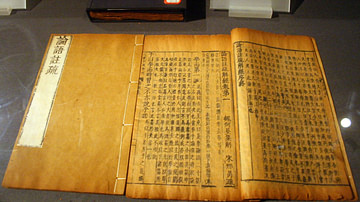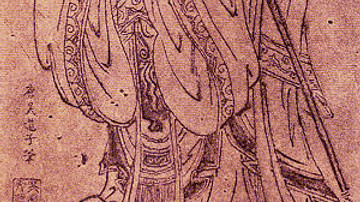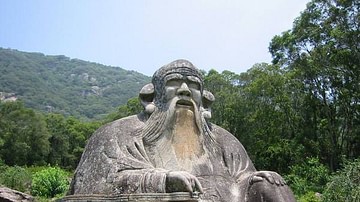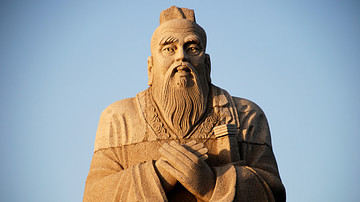
Lao-Tzu (l. c. 500 BCE, also known as Laozi or Lao-Tze) was a Chinese philosopher credited with founding the philosophical system of Taoism. He is best known as the author of the Laozi (later retitled the Tao-Te-Ching translated as “The Way of Virtue” or “The Classic of the Way and Virtue”) the work which exemplifies his thought.
The name by which he is known is not a personal name but an honorific title meaning 'Old Man' or 'Old Master' and the debate continues as to whether an individual by that name ever existed or whether Lao-Tzu is an amalgam of many different philosophers. The historian Will Durant comments:
Lao-Tze, greatest of the pre-Confucian philosophers, was wiser than Teng Shih; he knew the wisdom of silence, and lived, we may be sure, to a ripe old age – though we are not sure that he lived at all. (652)
Durant expresses the scholarly consensus on the historicity of Lao-Tzu in that he may be a fictitious character created to embody the concept of the sage. At the same time, according to Chinese tradition, he was an actual historical figure and, in religious Taoism, he is understood as a deity.
If he did exist, he is thought to have lived in the 6th century BCE. According to legend, Lao-Tzu tried his best to instruct people in the way of the Tao, the creative and binding force which runs through the universe, but no one would listen. His explanation that people could live happier, more fulfilling, lives by aligning themselves with the natural flow of the Tao, instead of placing themselves in opposition to it, went unheeded and, finally, he decided to leave humanity behind and retire into seclusion after writing the Tao-Te-Ching.
Legends concerning Lao-Tzu also claim he was the contemporary and teacher of Confucius (l. 551-479 BCE), founder of Confucianism which, in its original form, was closer to Taoism. Modern-day scholarship dismisses this claim, as well as Lao-Tzu as the author of the Tao-Te-Ching, maintaining the work was most likely created by multiple authors under the name Laozi.
Whenever it was written, or by whom, its value was recognized during the Han Dynasty (202 BCE - 220 CE) and its reputation grew afterwards to inform the culture of the great Tang Dynasty (618-907 CE). Today it is regarded as a classic of Chinese philosophical-religious literature and has influenced millions of people around the world.
Lao-Tzu & Taoism
All that is known of Lao-Tzu comes from the classic work Records of the Grand Historian by the Han Dynasty writer Sima Qian (l. 145/135-86 BCE). Sima, working from older historical and literary documents, claims that Lao-Tzu was one of the curators at the Royal Library in the state of Chu and was known as a philosopher. He advocated a deep, connective empathy between people as the means to peace and harmony and claimed that such empathy was possible through recognition of the cosmic force of the Tao which had created all things, bound all things, moved all things, and finally loosed all things back into their original state. Aligning one's self with the Tao, according to Lao-Tzu, brought one into harmony with the universe and enriched one's life; opposition to the Tao only brought frustration, unhappiness, and anger which resulted in bad behavior.
He was especially interested in converting the ruling class to his belief because the country was, at this time, in the midst of the era known as the Warring States Period (c. 481-221 BCE) during which seven states fought each other nearly constantly for supremacy and control of the Chinese government. The Zhou Dynasty (1046-256 BCE) was in decline and could do nothing to maintain order because the separate states were all more powerful than the government but evenly matched against each other.
The wars continued and various schools of Chinese philosophy were established which tried to suggest the best way to end the violence and establish a moral government that would care for its citizens. Lao-Tzu, according to Sima Qian, persisted in his efforts to convince people to accept the Tao and live a life in harmony with each other and the universe, and when he finally understood they never would listen to him, he abandoned human society for self-exile.
On his way out of China, by way of the Western Pass, the gatekeeper, Yin Hsi, recognized him and asked him to please write down his philosophy before leaving humanity behind. Lao-Tzu took the materials from Yin Hsi, wrote until he had nothing left to say, handed the manuscript to him, and walked through the pass, never to be seen again. Yin Hsi, presumably, then had the manuscript published.
It is unlikely that any of this ever happened, however, because Taoism – in more or less the same way it is expressed in the Tao-Te-Ching – developed during the Shang Dynasty (c. 1600-1046 BCE) from the same folk belief and understanding which produced the I-Ching, a book of divination, which was informed by the concept of the principles of yin and yang. Scholar John M. Koller comments:
Yin-yang thought began as an attempt to answer the question of the origin of the universe. According to yin-yang thought, the universe came to be as a result of the interactions between the two primordial opposing forces of yin and yang. Because things are experienced as changing, as processes coming into being and passing out of being, they must have both yang, or being, and yin, or lack of being. The world of changing things that constitutes nature can exist only when there are both yang and yin. Without yang nothing can come into existence. Without yin nothing can pass out of existence. (207)
This concept was later adapted by the polymath Zou Yan (l. 305-240 BCE) who founded the Yin-Yang School, one of the many – including Taoism – which are recognized from the period known as the Hundred Schools of Thought from the Spring and Autumn Period (c. 772-476 BCE) and Warring States Period. It could be argued that Zou Yan took the principles of the yin-yang from Lao-Tzu, but this is unlikely as it seems clear it existed centuries prior to his supposed existence.
Further, the same basic concept of dualistic forces in constant motion informed the concept of Tian (Heaven) as recognized by the philosophies of Confucianism and Mohism, among others. Even so, tradition still maintains that Lao-Tzu is the author of the Tao-Te-Ching and that the work represents his last words to humanity.
The Tao-Te-Ching
The Tao-Te-Ching is an anti-authoritarian treatise which posits that the way of virtue lies in non-action (Wu Wei) through a recognition of the natural, universal force known as the Tao. The Tao flows without effort and, like water, goes where it will without striving and effects change and growth. To be virtuous, one should emulate the Tao and engage in non-action (not forcing an effect or outcome). Human-made laws, it claims, cannot make one virtuous and cannot contribute to good behavior, inner peace, or empathy with others because they are not in tune with nature. It is only by recognizing the Tao, and one's connection to it and all things, that one may achieve these goals. To recognize the Tao, one must know what it is, and so it is defined in the first chapter:
The Tao that can be told of is not the eternal Tao;
The name that can be named is not the eternal name.
The Nameless is the origin of Heaven and earth;
The Named is the mother of all things.
Therefore, let there always be non-being, so we may see their subtlety,
And let there always be being, so we may see their outcome.
The two are the same,
But after they are produced, they have different names. (Verse I; Baird, 371)
The verse here is relating the intangible concept of being-and-non-being, of yin-and-yang, of the constant dynamic motion of the universe which keeps creation in balance. That which actually is cannot be comprehended by the human mind and so that which can be known is what is named, and this is the Tao; it is not the actual Tao but it points the way toward the Tao.
One cannot grasp the actual Tao through intellectual pursuits but, rather, by submitting to and expressing its essence in one's life, through self-reflection and harmonious interaction with others. Rulers, especially, are encouraged to embrace the Tao since, by their example, their subjects will do likewise. According to the Tao-Te-Ching, the best ruler is one who governs so effortlessly that it seems he has done nothing, and yet everything has been done (Verse 17). The best individual is the one who can recognize the current of existence and move with it, as effortlessly as water flowing, without upset or resistance, as in the famous passage:
Yield and overcome
Bend and become straight
Empty and become full. (Verse 22)
This verse has become one of the most iconic in that it distills the message of Taoism regarding inner peace, accord with others, and personal success, in three lines:
- Yield and Overcome: one cannot fully listen to another person's views if one is full of one's own; yielding to another encourages personal growth.
- Bend and become Straight: one cannot reach an accord with someone else if one is unwilling to compromise and one cannot correct bad behavior if one is unable to accept criticism.
- Empty and become Full: one has little hope of success, in any enterprise or relationship, if one clings to what one thinks one knows instead of opening one's self to new ideas and other views.
Verse 22 expresses the heart of the Taoist message that, when one is in alignment with the natural flow of energies of the universe, one is able to live more easily with one's self and others through non-resistance or non-action. One does not resist other people's views or new concepts but flows with them, again like water, picking up and carrying what is useful and discarding what is not, what is too heavy to be carried.
Lao-Tzu's Taoism – or, at least, the Taoism of the 6th century BCE – emphasized the importance of non-action, non-resistance, “going with the flow” to live an elevated and transformative life. In so doing, it refuted Confucius' philosophy and its insistence on education, knowledge-as-power, and strict adherence to social custom and ritual in improving one's character and quality of life. Lao-Tzu's claim (paraphrased) that “the more rules one makes, the more criminals one creates” is the antithesis of Confucius's assertion that adherence to ritual improves one's moral character and produces better citizens.
Taoism & Confucianism
Even so, the two systems have much in common. As noted, legends claim that Lao-Tzu was Confucius' mentor and teacher which suggests an early association between the two philosophies. While the Lao-Tzu/Confucius claim has been challenged (and largely dismissed), the two systems share a number of similarities which are often ignored in favor of highlighting their differences. The Hundred Schools of Thought produced many different philosophies which contended for adherents and, among them, three became most prominent – Confucianism, Taoism, and Legalism – all three of which would be influenced by the other schools of thought and each other and would go on to significantly inform Chinese culture.
Of them all, Legalism was the most unchanged and would always remain a social philosophy based on the understanding that human beings were innately selfish and self-centered and required strict laws and guidelines to restrain their negative impulses. Confucianism and Taoism, on the other hand, both developed and began with the recognition of some higher power. They are regarded as philosophies as well as religions as they both include metaphysical speculation and rely upon a higher, unseen, force to validate their claims. In Confucianism, this power is Tian, in Taoism, it is the Tao, but both of these concepts are informed by the yin-yang principle of the constant flux of the universe.
Taoism, which advocated adherence to the universal Tao long before the Tao-Te-Ching, was practiced through ancestor worship and an acknowledgment of the natural law of the Tao in all things, which enabled personal and community balance. Confucianism, which also acknowledged the importance of ancestor worship as part of filial piety, recognized Tian as the stabilizing force of the universe, which encouraged the same. The difference between the two had to do with the emphasis on ritual and social custom. Taoism, officially at least, repudiated these practices; Confucianism embraced them.
According to Taoism, all human beings are naturally good but are corrupted by unjust law and an incorrect belief in how they are supposed to behave in society. By trying to regulate people's behavior through the law, the government only worsens their behavior because it creates an artificial environment which human beings rebel against in an effort to maintain their natural state of harmony. If rulers recognized the Tao and aligned themselves with the flow of the energy of the universe, they would enact laws in accord with natural rhythms and their subjects would respond with respect and proper behavior.
Confucianism says the same thing but within a different paradigm. Tian is the regulating force of the universe, which people, who are essentially good, respond to but, because they lack proper education and guidance, fall short of becoming their best selves. Through education and observance of ritual and social custom, one aligned one's self with the order of the universe and recognized the value of respect for one's self, others, and authority. In this way, Confucius said, people would naturally behave well, respecting both themselves and others.
Lao-Tzu maintained, as did the sophist Teng Shih (l. c. 500 BCE) that people behaved badly because they were forced to through poor government and unjust laws. Confucianism said the same thing and, in fact, both Confucius and the later Confucian sage Mencius (l. 372-289 BCE), traveled to the different warring states to try to convince them to adopt policies of morality, virtue, and peace.
The two systems, whose differences are often overly contrasted, shared much in common but diverged (again, officially at least) when it came to formal education and knowledge. Knowledge was among the central values of Confucianism expressed, to cite only one example, in Analects VII.2: “To gain knowledge quietly, to learn without losing interest, to instruct others relentlessly,” while Taoism rejected formal education and 'book knowledge' in favor of natural intelligence: “Abandon learning and there will be no sorrow” (Verse 20.1). By this, Taoism was not dismissing knowledge per se, only formal education and the value placed on the social standing associated with it.
Conclusion
Confucianism and Taoism, as well as the other systems articulated by the Hundred Schools of Thought, were banned when the Warring States Period ended in the victory of the state of Qin and the establishment of the Qin Dynasty (221-206 BCE). Between 213-210 BCE, all books, except those on Qin history, Legalism, and practical measures, were burned and scholars were executed. The only reason some texts survived was because they were hidden by people who understood their value.
After the Qin Dynasty fell, the Han Dynasty revived these works and they were again disseminated. Confucianism became the state philosophy under the reign of the Han emperor Wu the Great (141-87 CE) but, by that time, the systems of Confucianism and Taoism had absorbed concepts from other schools so their formulation by the time of the Han was almost certainly different from their early visions. Confucianism, by this time, had been reformed by Mencius and Xunzi (l. c. 310 - c. 235 BCE) and was far more developed than the form conceived by Confucius.
By the time Taoism was adopted as the state philosophy by the Tang Dynasty (618-907 CE), it had also developed and was a far more rigid system than expressed by the Tao-Te-Ching, observing rituals the work itself would have dismissed as superfluous. At this same time, Taoism was also considered a religion with Lao-Tzu as one of its deities among many others.
In the present day, Taoism is recognized as a philosophy, a religion, and, in one aspect, a pop-culture phenomenon. Its concept of a cosmic current flowing through and binding all things served as the inspiration for the Force in the Star Wars franchise and the image of the Taoist sage Lao-Tzu, and those who followed him, informed the paradigm of the Jedi Knights.
Whether there ever was a Lao-Tzu who wrote the Tao-Te-Ching before cutting ties with humanity hardly matters anymore. The philosophy he may or may not have founded has long ago taken on a life of its own and continues to develop as it attracts more adherents intrigued by the vision it presents of a life lived in accord with the natural world as opposed to one which struggles against it.












